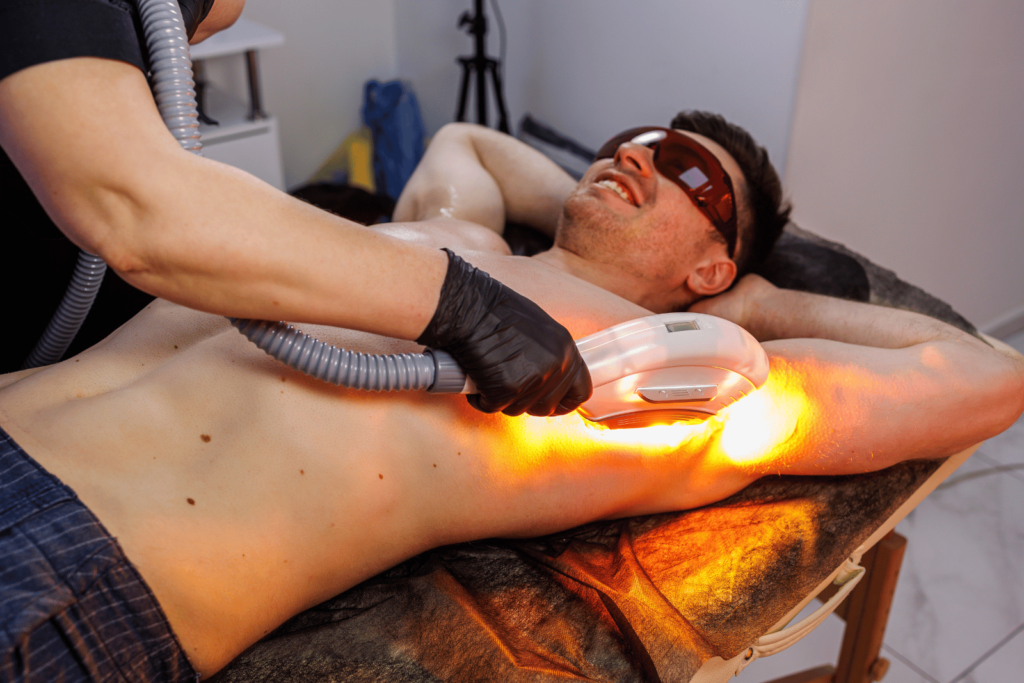Laser hair removal is a well-established cosmetic procedure for reducing unwanted hair and is favored for its long-lasting results compared to traditional methods like shaving and waxing. But is it a permanent solution for removing body hair, or are touch-ups required after the initial treatments? This blog explores the mechanics of laser hair removal, its effectiveness, risks, and what to expect during the process.
What Is Laser Hair Removal?
Laser hair removal is a non-invasive cosmetic procedure designed to remove unwanted hair by targeting the hair follicle. A laser emits a focused beam of light, which is absorbed by the pigment in the hair follicle, causing damage that reduces hair growth over time.
The primary goal of laser hair removal is to delay hair regrowth. Although it’s often referred to as a permanent hair removal solution, in most cases, the procedure results in long-term hair reduction rather than complete and permanent removal of hair.

How Does Laser Hair Removal Work?
Laser hair removal works based on a principle called selective photothermolysis, where the laser light is absorbed by melanin in the hair without affecting the surrounding skin. Here’s how it works:
- Laser Targets Hair Follicles: The laser generates a pulse of light that penetrates the skin to reach the root of the hair follicle.
- Heat Generation: The light is converted into heat, damaging the hair follicle to delay or stop future hair growth.
- Growth Cycle Interruption: By targeting the follicles in the active growth phase (anagen), the laser inhibits hair from growing back for an extended period.
Laser hair removal is most effective on light skin with dark hair, though new technologies have made it increasingly accessible to various skin tones.
Is Laser Hair Removal Permanent?
In most cases, laser hair removal provides long-term results but not complete permanent hair removal. After a full series of treatments, most people experience a significant reduction in hair growth. The treated areas may remain hair-free for months or even years, but some hair regrowth is possible over time.
Factors influencing the permanence of results include:
- Hair color and texture: Dark, coarse hair responds best to laser treatment.
- Skin tone: Light skin with dark hair is the ideal combination, but new lasers can also treat darker skin tones.
- Hormonal changes: Conditions like pregnancy or polycystic ovary syndrome (PCOS) can stimulate hair regrowth even after laser treatments.
To maintain smooth, hair-free skin, maintenance sessions may be needed every year or so.
Why Are Multiple Sessions Necessary for Laser Hair Removal?
Laser hair removal requires multiple sessions because of the hair growth cycle. Hair grows in three phases: anagen (growth), catagen (transitional), and telogen (resting). The laser is most effective on hair in the anagen phase. However, not all hair is in the same phase at the same time, which is why multiple sessions are needed to treat every hair follicle.
Typically, 6 to 8 sessions are required for significant results. Each session is spaced 4-6 weeks apart to align with the hair growth cycles. After completing the initial set of treatments, touch-up sessions may be necessary depending on the individual’s hair growth pattern and hormonal influences.
The Benefits of Laser Hair Removal
One of the biggest benefits of laser hair removal is its ability to provide long-lasting results compared to other hair removal methods. Here are some key advantages:
- Precision: Lasers can target dark, coarse hairs without damaging the surrounding skin.
- Speed: Each pulse of the laser takes a fraction of a second and can treat multiple hairs at once. Small areas like the upper lip can be treated in minutes, while larger areas like the back or legs take around an hour.
- Less regrowth: Hair that does grow back is typically finer and lighter in color, making it less noticeable.
- Reduction of ingrown hairs: Since the hair is being removed from the root, laser hair removal helps reduce the incidence of ingrown hairs.
Is Laser Hair Removal Safe? Risks and Side Effects
Laser hair removal is a relatively safe procedure, but like any treatment, it comes with certain risks and side effects. The most common side effects include:
- Redness and swelling: Immediately after treatment, the skin may be red or swollen, similar to a mild sunburn. This usually subsides within a few hours.
- Skin irritation: Temporary irritation, such as blistering or crusting, can occur, but it is rare when proper aftercare is followed.
- Pigment changes: People with darker skin tones might experience temporary hyperpigmentation (dark spots) or hypopigmentation (light spots), but these are typically temporary.
- Burns and scars: These are uncommon but can occur if the wrong laser settings are used or the procedure is performed by an inexperienced technician.
It’s essential to have laser hair removal done by a certified and experienced professional to minimize these risks.
Preparation for Laser Hair Removal: What to Expect
Before undergoing laser hair removal, your provider will give you specific instructions on how to prepare for the treatment. Here’s what you should do:
- Shave the area: Shaving the treatment area 24-48 hours beforehand ensures that the laser targets the hair follicle, not the surface hair.
- Avoid sun exposure: Stay out of the sun for at least two weeks before treatment to prevent tanning, which increases the risk of side effects like burns or pigmentation changes.
- Stop waxing and plucking: Don’t remove hair from the root (via waxing or plucking) for at least 4-6 weeks before your appointment. The laser needs the follicle to be intact for the treatment to work.
- Avoid certain skincare products: Refrain from using retinoids or other harsh skincare products on the treatment area a few days before the procedure.
Post-Treatment Care: Ensuring Optimal Results
After a laser hair removal session, taking care of your skin is crucial to avoid side effects and ensure effective results. Here’s what to do:
- Avoid sun exposure: Like before the treatment, stay out of the sun to prevent pigmentation changes.
- Use gentle skincare products: Opt for soothing products like aloe vera or fragrance-free lotions to calm the skin.
- Avoid hot showers and saunas: Refrain from exposing the treated area to heat for 24-48 hours after treatment to prevent irritation.
Following these steps will help reduce the risk of side effects and improve the longevity of your results.
Laser Hair Removal for Different Skin and Hair Types
Advances in laser technology have made the procedure accessible to a broader range of skin tones and hair types. For instance, the Nd
laser is safer and more effective for darker skin tones, as it bypasses the melanin in the skin and targets the hair follicle directly.
However, laser hair removal may be less effective for light-colored hair (such as blonde, gray, or red hair) because the laser relies on melanin to absorb light. New technologies, like combination lasers and IPL (intense pulsed light), are improving outcomes for people with lighter hair.
Common FAQs About Laser Hair Removal
1. Does laser hair removal work on all hair types?
Laser hair removal is most effective on dark, coarse hair. It’s less effective on fine, light-colored hair, although newer technologies are improving this.
2. Is the procedure painful?
Most people describe the sensation as similar to a rubber band snapping against the skin. Some areas, like the bikini line or upper lip, may feel more sensitive than others.
3. How long do the results last?
After completing a series of treatments, results can last for months or even years. Occasional touch-up sessions may be needed, especially in areas prone to hormonal hair growth, like the face.
4. Are there any risks associated with laser hair removal?
Laser hair removal is generally safe when performed by an experienced technician. However, side effects like redness, swelling, and changes in skin color can occur.
5. How many sessions are needed for optimal results?
Most people need 6 to 8 sessions spaced 4-6 weeks apart. The exact number varies depending on hair type, body area, and individual hair growth cycles.
6. Can I have laser hair removal done if I have a tattoo?
It’s best to avoid laser hair removal over tattoos, as the laser can cause damage to the tattoo and surrounding skin.
Conclusion: Is Laser Hair Removal Worth It?
While laser hair removal may not offer 100% permanent results, it is an effective and long-lasting method for reducing unwanted hair. With multiple sessions, most people experience a significant reduction in hair growth that lasts for years. Touch-up treatments can maintain smooth skin over time, making it a worthwhile investment for those looking to avoid the hassle of frequent shaving or waxing.

